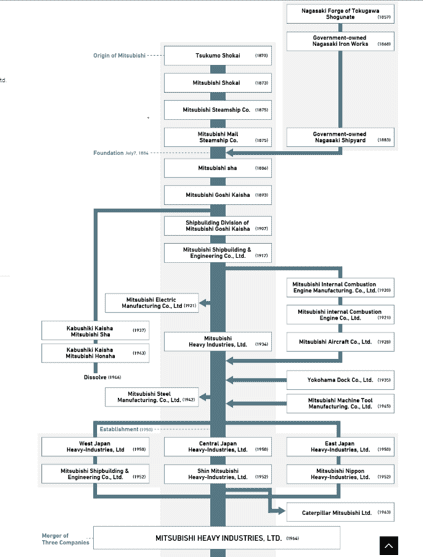Mitsubishi History
In that year, Yataro Iwasaki – the founder of Mitsubishi, took a lease out on government-owned Nagasaki Shipyard. He named it Nagasaki Shipyard & Machinery Works, and started the shipbuilding business on a full scale.
This shipbuilding business was later turned into Mitsubishi Shipbuilding Co., Ltd., and then launched as Mitsubishi Heavy-Industries, Ltd. in 1934, establishing its position as the largest private firm in Japan, manufacturing ships, heavy machinery, airplanes, and railroad cars.
Following the end of World War II, a law aimed at dissolving "zaibatsu" or Nagasaki Shipyard & Machinery Works dismantling the over concentration of economic power was in effect. Thus, in 1950, Mitsubishi Heavy Industries (MHI) was divided into three entities: West Japan Heavy-Industries, Ltd., Central Japan Heavy-Industries, Ltd. and East Japan Heavy-Industries, Ltd. It was later consolidated in 1964 and reborn as Mitsubishi Heavy Industries, Ltd.
In 1970, Mitsubishi Heavy Industries's (MHI) automobile department became independent and Mitsubishi Motors Corporation began manufacturing and marketing automobiles.
Integrating each company's management and technical expertise and enhancing competitiveness in domestic and international markets, Mitsubishi Heavy Industries (MHI) has come a long way.

The "Three Diamonds", company symbol of Mitsubishi Heavy Industries, Ltd.
The "Three Diamonds", company symbol of Mitsubishi Heavy Industries, Ltd., originated with the symbol of the ship's flag which the company's forefather, Tsukumo Shokai, adopted when it started the shipping business. This symbol is a transformed version of the family emblem of Yataro Iwasaki, the founder of Mitsubishi. In October 1, 2016, the airconditioning division of Mitsubishi Heavy Industries (MHI) group became a seperate corporation and named as Mitsubishi Heavy Industries Thermal Systems (MTH).

